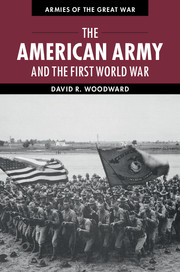Book contents
- Frontmatter
- Dedication
- Contents
- List of figures
- List of maps
- List of tables
- Preface
- List of abbreviations
- Introduction
- 1 Birth of a modern army
- 2 World war and American preparedness
- 3 Coercive power and Wilsonian diplomacy
- 4 “You’re in the army now”
- 5 US army doctrine and industrialized trench warfare
- 6 Over where?
- 7 American Expeditionary Force organization, overseas training, and deployment
- 8 Will the Americans arrive in time?
- 9 Failed expectations: “the military establishment of the United States has fallen down”
- 10 Atlantic ferry
- 11 Neck of the bottle
- 12 Uncertain times
- 13 Cantigny
- 14 Into the breach
- 15 American soldiers in north Russia and Siberia
- 16 The beginning of the end
- 17 Establishment of the American First Army and Saint-Mihiel
- 18 Meuse-Argonne, September 26–October 31
- 19 Breakout, November 1–11
- 20 Epilogue
- Notes
- Bibliography
- Index
8 - Will the Americans arrive in time?
Published online by Cambridge University Press: 05 July 2014
- Frontmatter
- Dedication
- Contents
- List of figures
- List of maps
- List of tables
- Preface
- List of abbreviations
- Introduction
- 1 Birth of a modern army
- 2 World war and American preparedness
- 3 Coercive power and Wilsonian diplomacy
- 4 “You’re in the army now”
- 5 US army doctrine and industrialized trench warfare
- 6 Over where?
- 7 American Expeditionary Force organization, overseas training, and deployment
- 8 Will the Americans arrive in time?
- 9 Failed expectations: “the military establishment of the United States has fallen down”
- 10 Atlantic ferry
- 11 Neck of the bottle
- 12 Uncertain times
- 13 Cantigny
- 14 Into the breach
- 15 American soldiers in north Russia and Siberia
- 16 The beginning of the end
- 17 Establishment of the American First Army and Saint-Mihiel
- 18 Meuse-Argonne, September 26–October 31
- 19 Breakout, November 1–11
- 20 Epilogue
- Notes
- Bibliography
- Index
Summary
As Pershing and his staff planned and prepared for a war-winning offensive in 1919, British and French war leaders by necessity focused on the present. Increasingly it became apparent to them that the flow of American reinforcements across the Atlantic would determine the war’s outcome. Russia’s headlong decline especially weighed on their minds. The overthrow of the Romanov dynasty in March had not revitalized the Russian Army. Outnumbering the Habsburg forces by a ratio of three to one, and supplied with British and French artillery, the so-called Kerensky offensive had been launched on July 1 towards Lemberg (or Lvov). Berlin responded by transferring eight German divisions to the Eastern Front and launching a counteroffensive on July 19. The plain-speaking “Wully” Robertson described the result: “The Russians broke, with the result that three Russian armies comprising some 60 to 70 divisions, well equipped with guns and ammunition, are now running away from some 18 Austrian and German divisions.” General Mikhail Vasilevich Alekseev, the Russian commander-in-chief who had resigned in protest against the Kerensky offensive, now proclaimed that the Russian Army “remained nothing but human dust.” If the Russian Army’s collapse portended Russia’s withdrawal from the war the strategic landscape would be dramatically altered in Germany’s favor. By transferring German divisions from the East, Berlin might be able to launch a war-winning offensive on the Western Front.
The encouraging arrival of the first American troops in June had coincided with a serious breakdown in discipline in the French Army that occurred in the wake of Nivelle’s failed offensive in April 1917. At its peak the mutiny affected fifty-four French divisions. Some soldiers refused orders to enter the trenches. Others were willing to defend their positions, but refused to take the offensive. Pétain’s appointment as commander-in-chief gradually contributed to a restoration of discipline, but under his leadership it soon became apparent to the British that they could count on the French for only limited support for the remainder of 1917.
- Type
- Chapter
- Information
- The American Army and the First World War , pp. 123 - 133Publisher: Cambridge University PressPrint publication year: 2014

